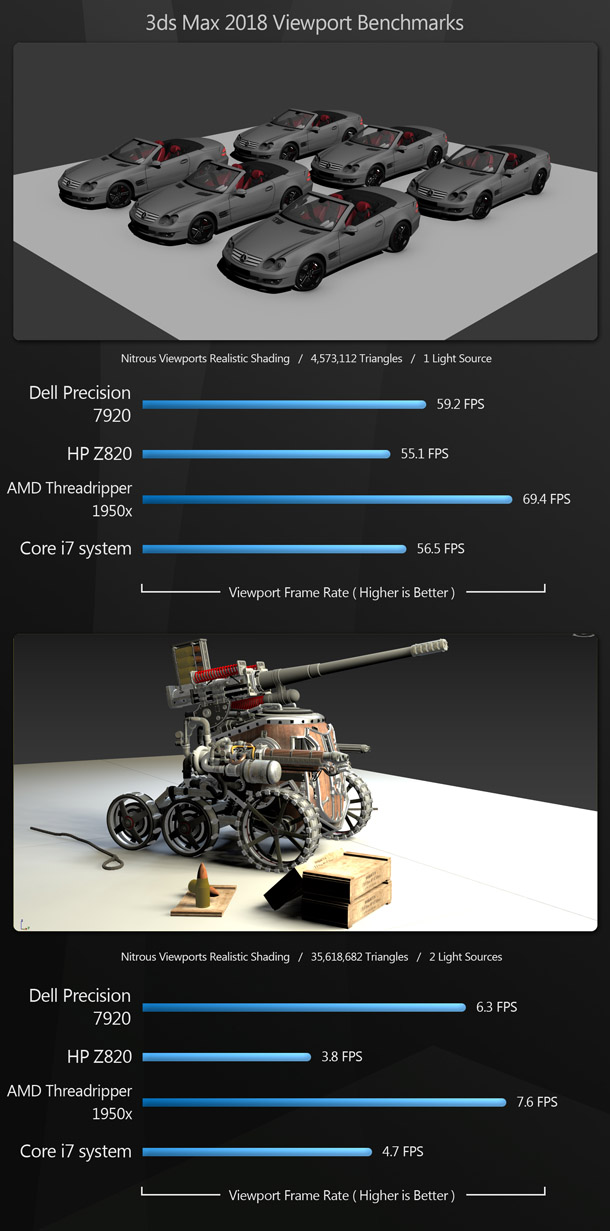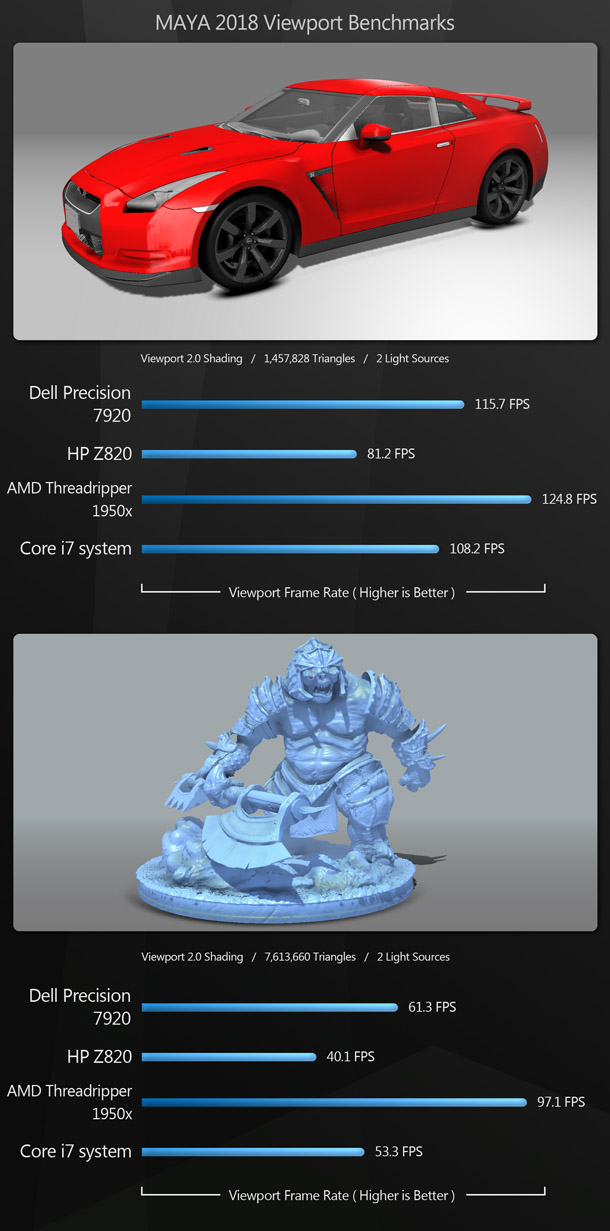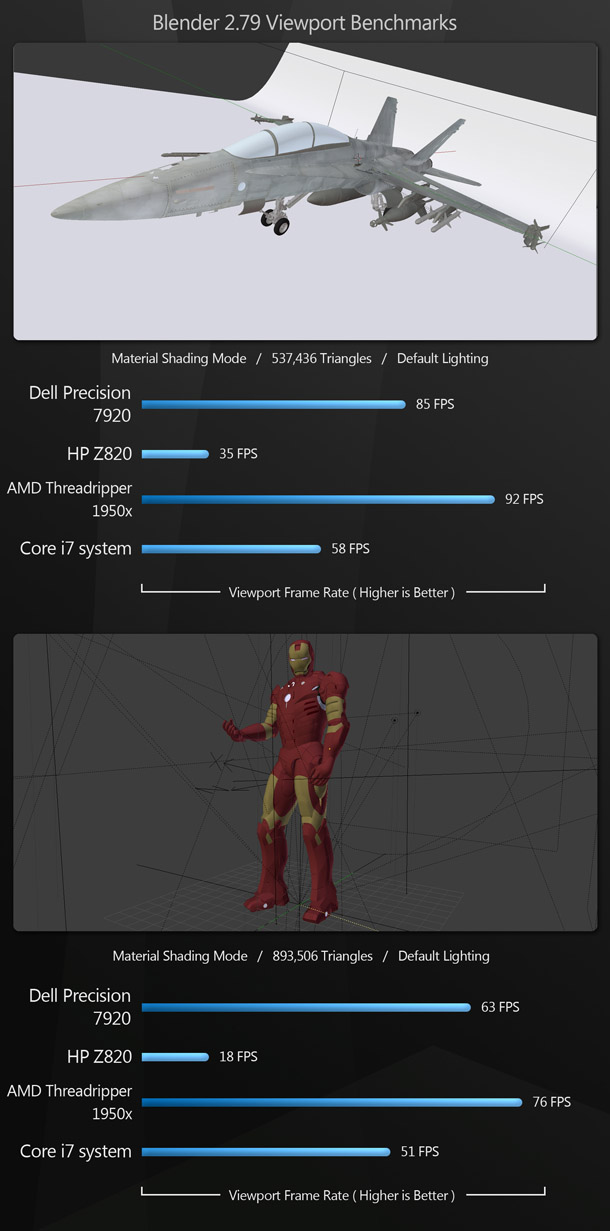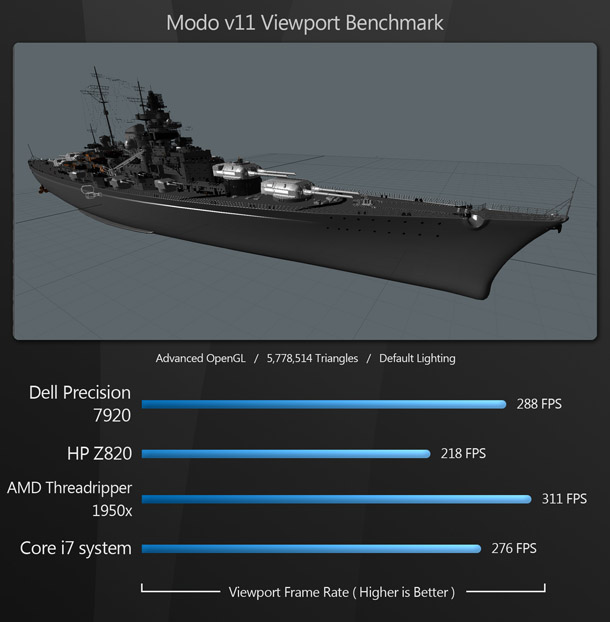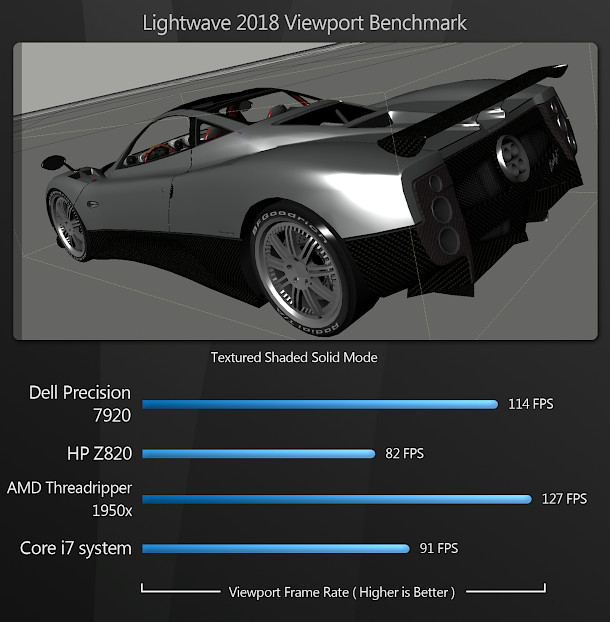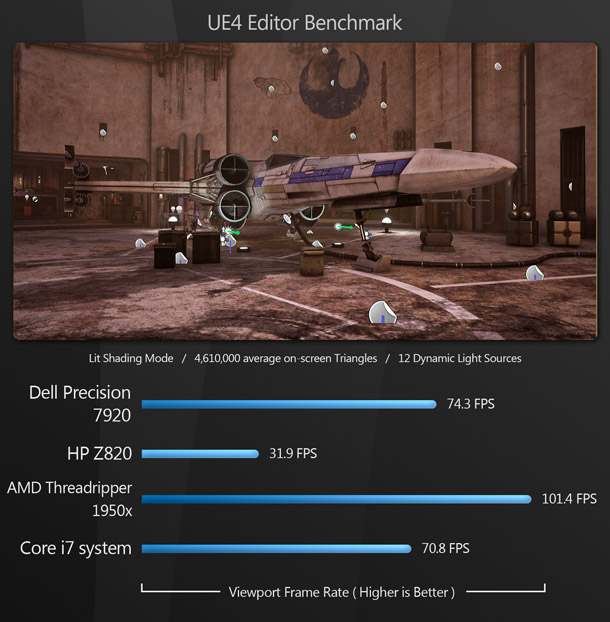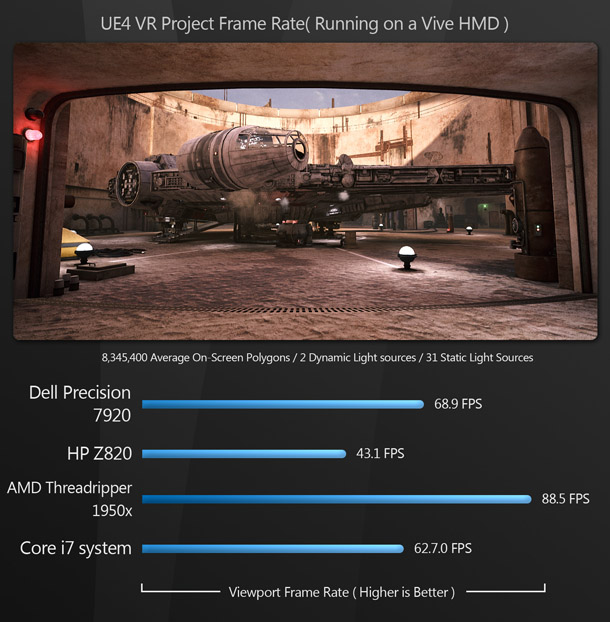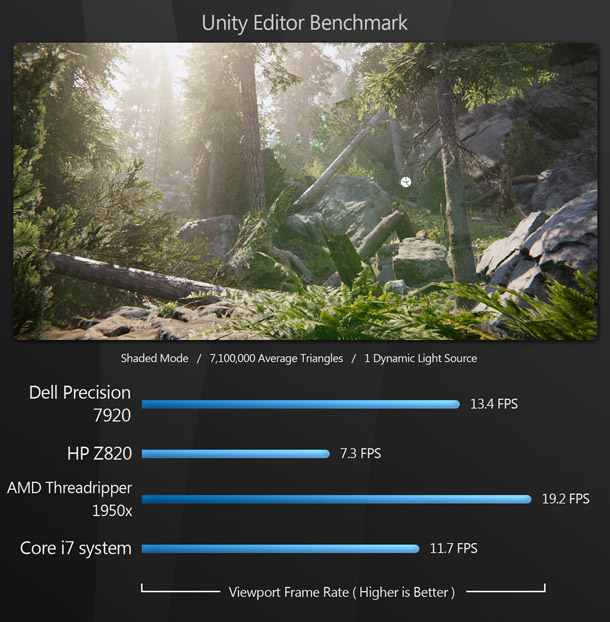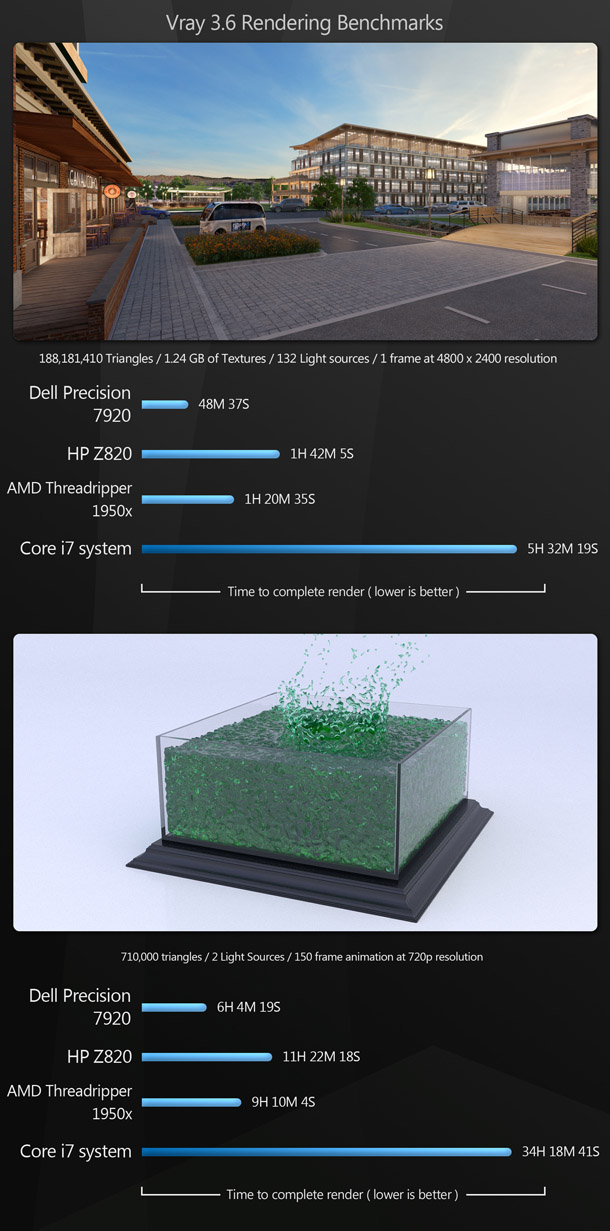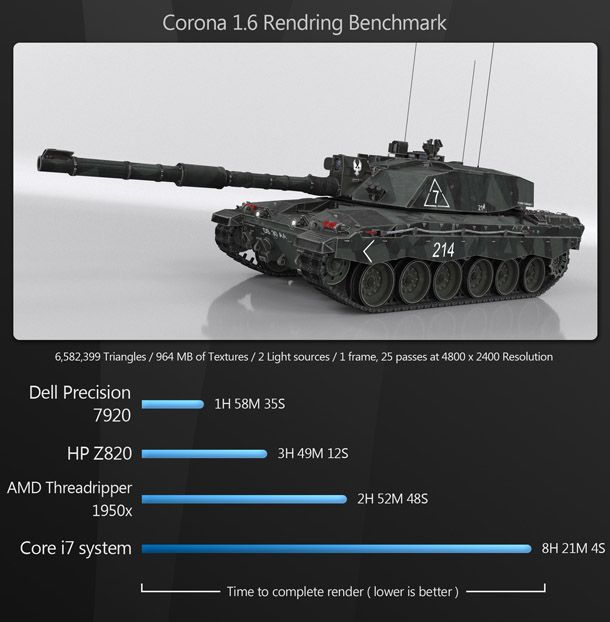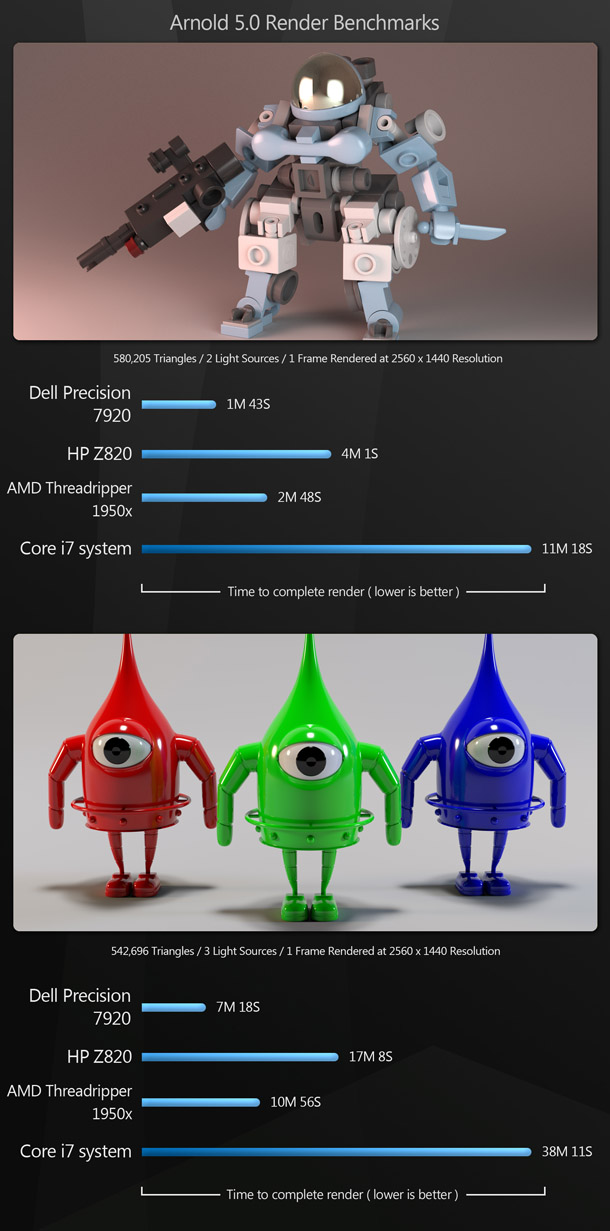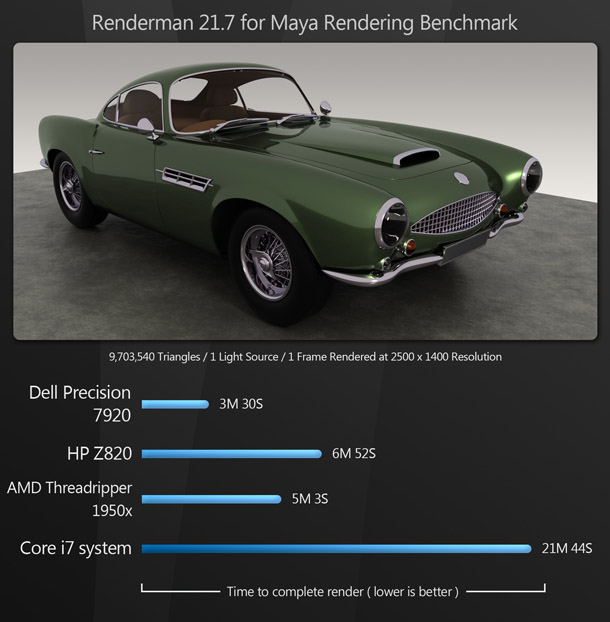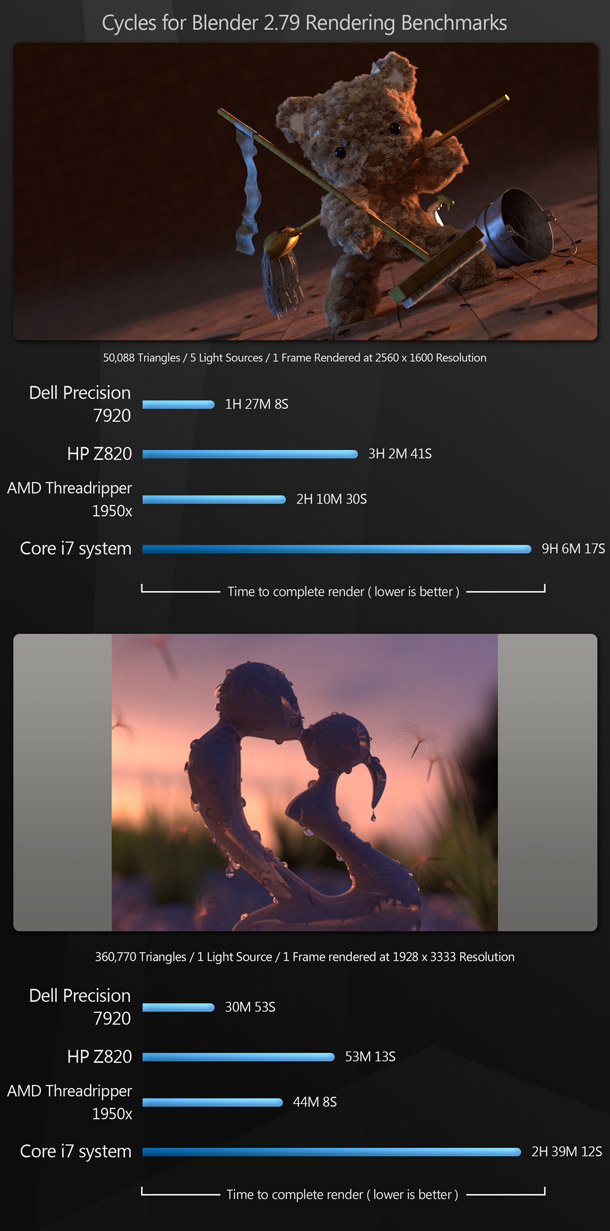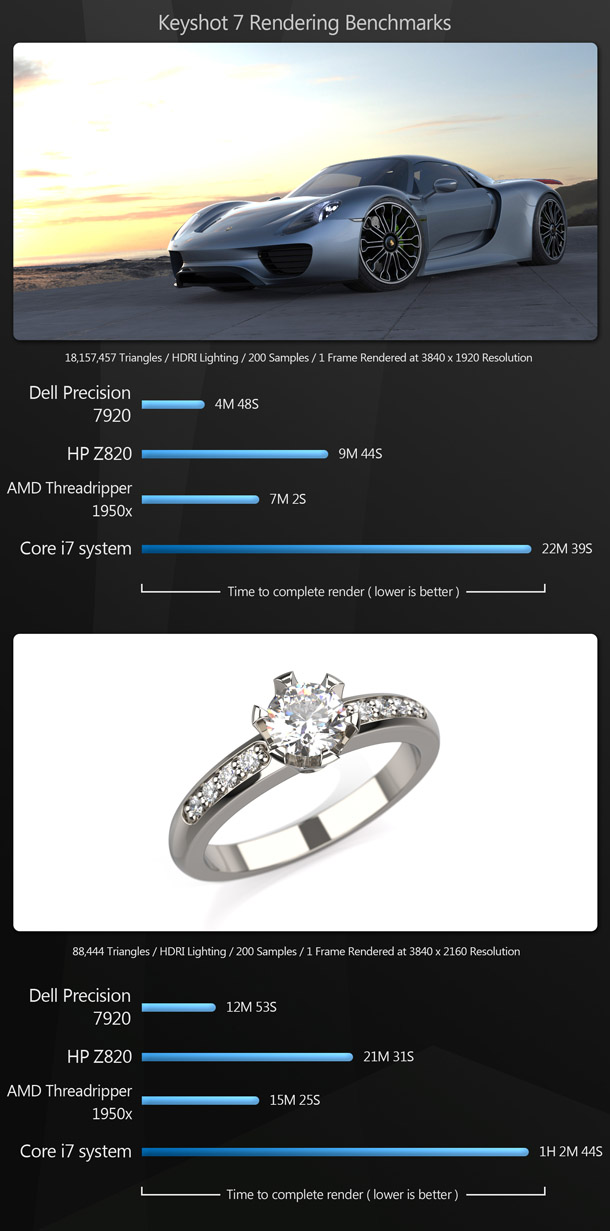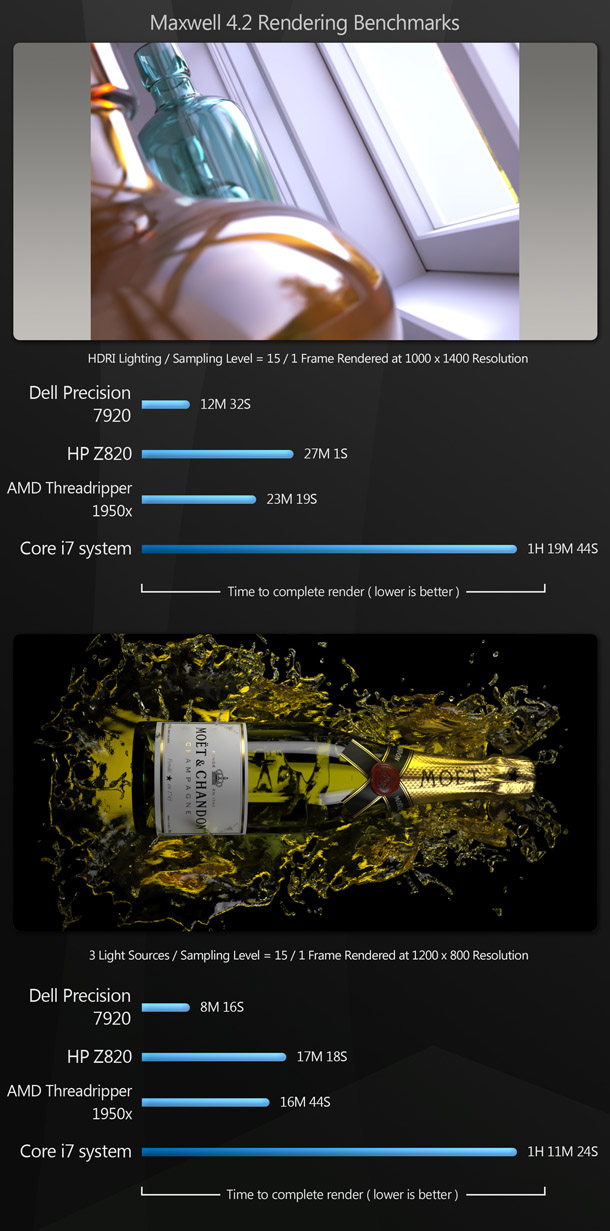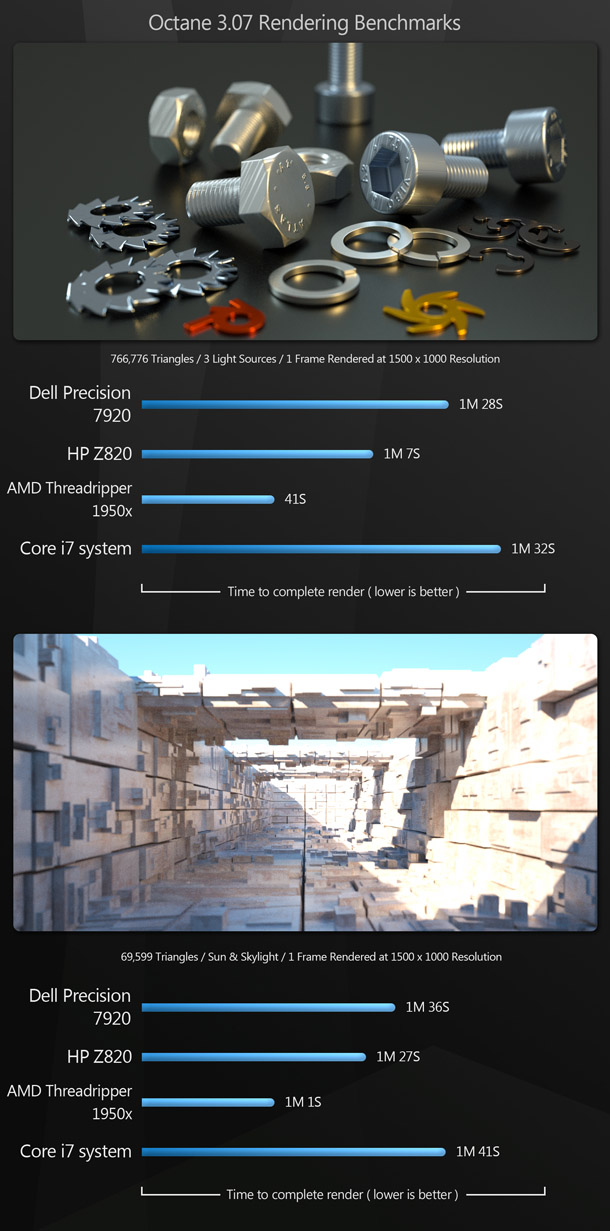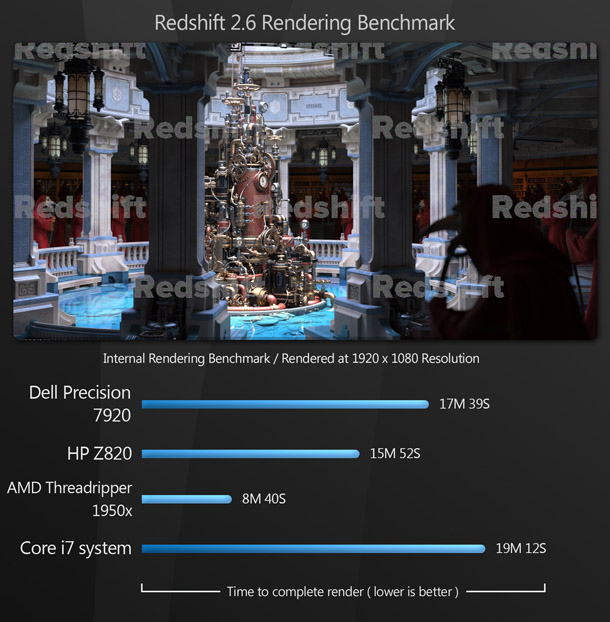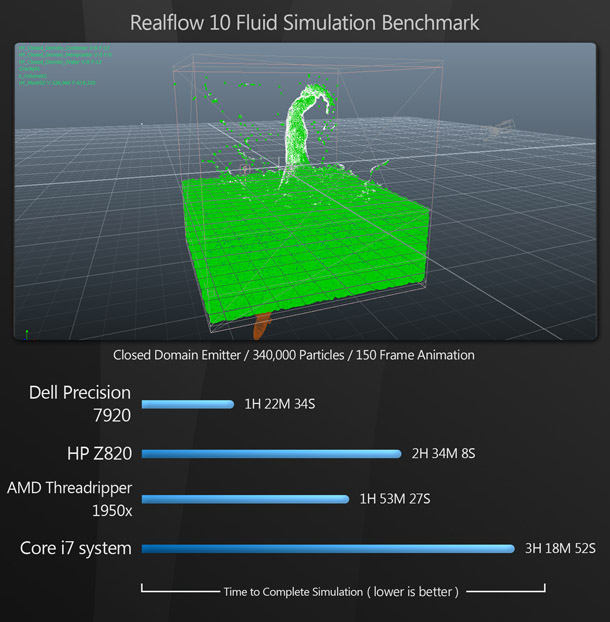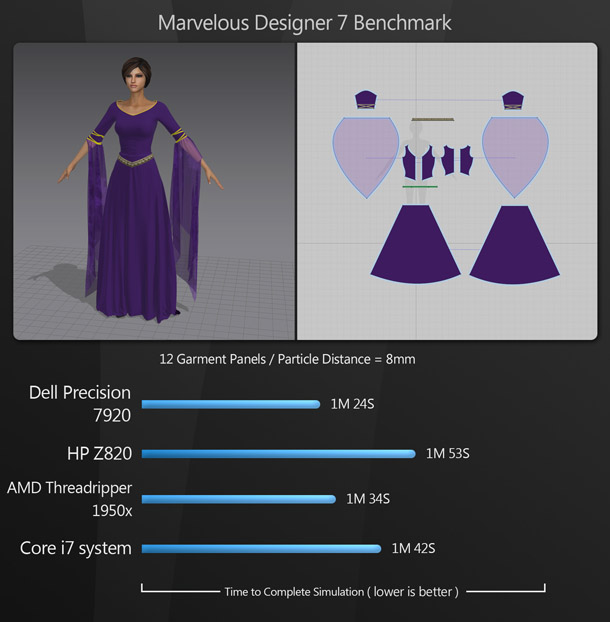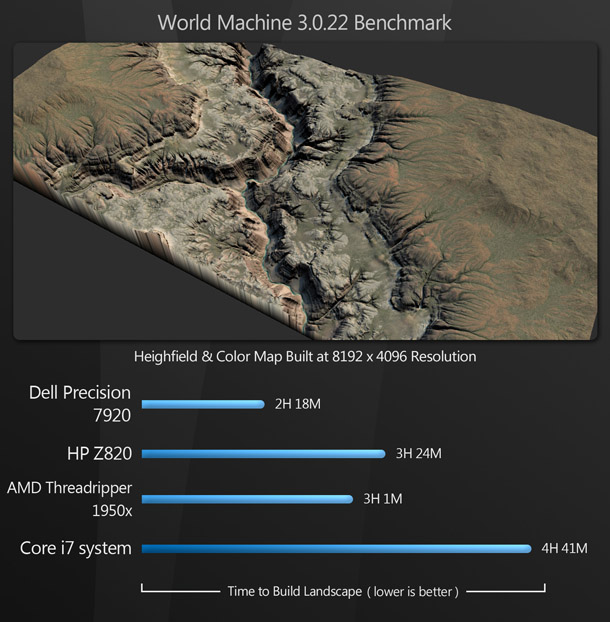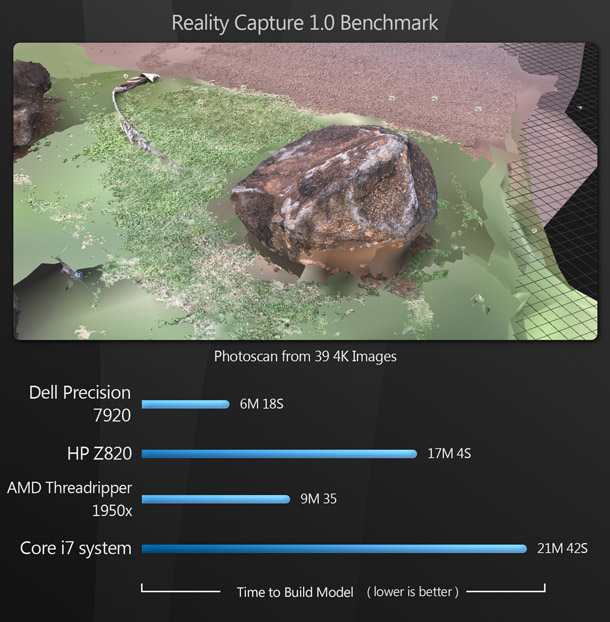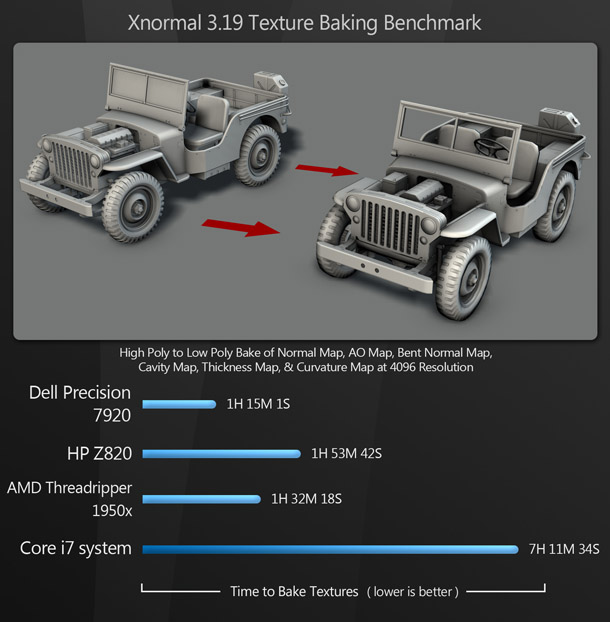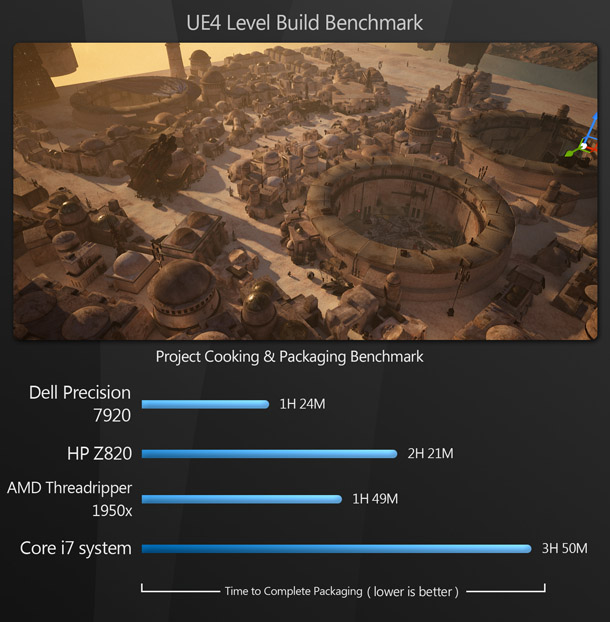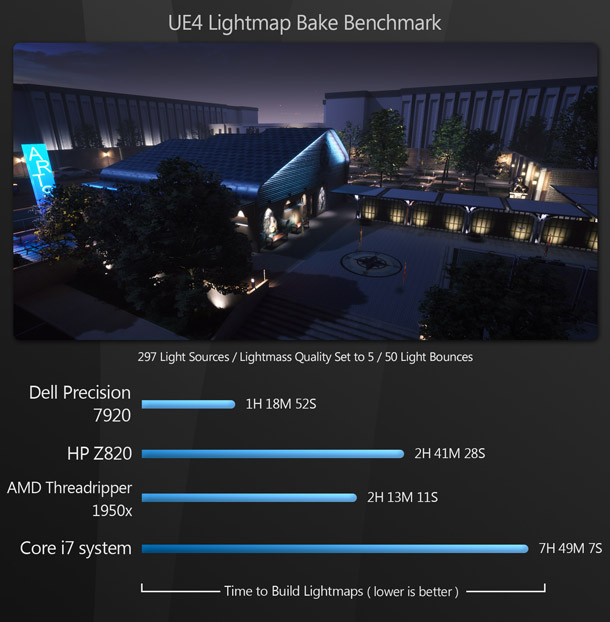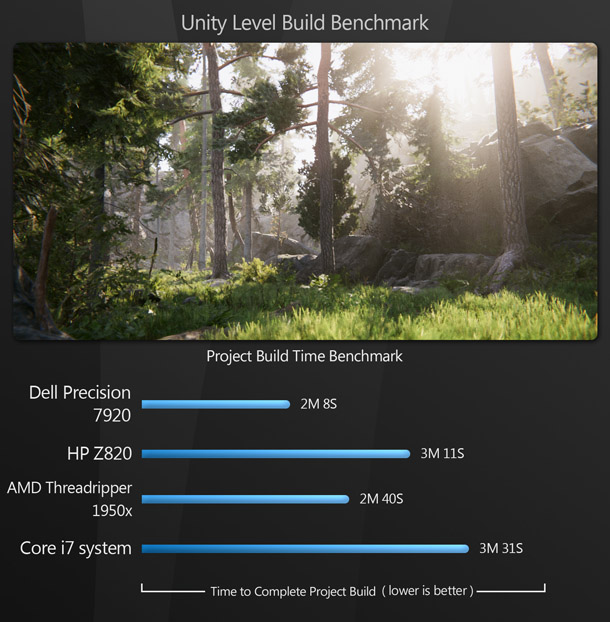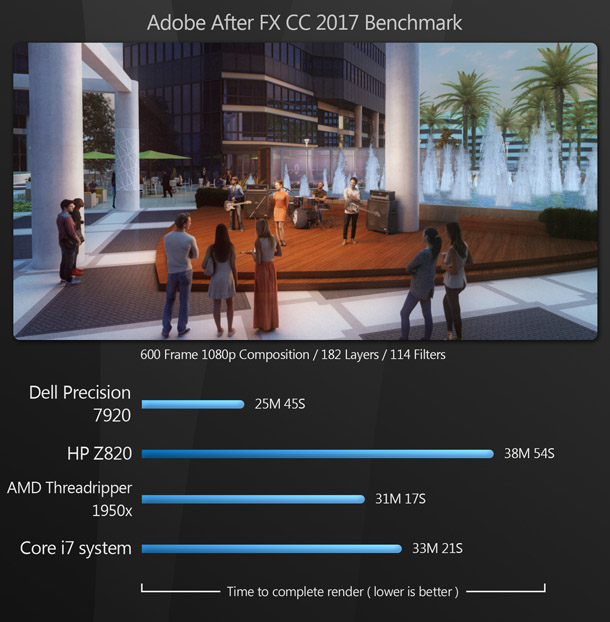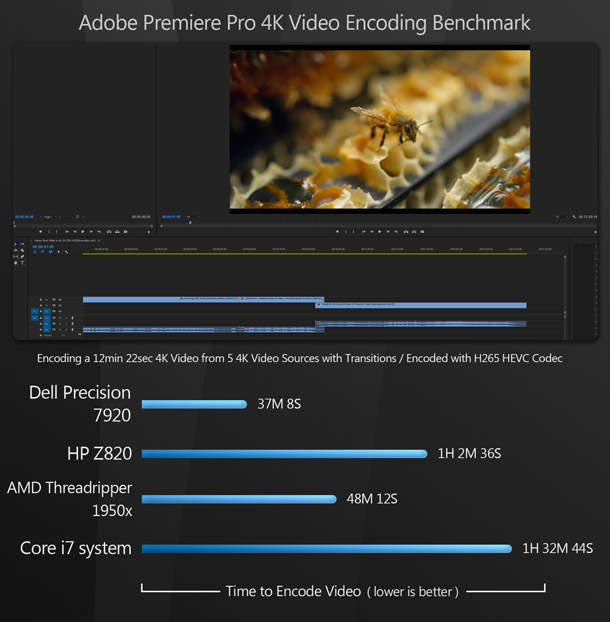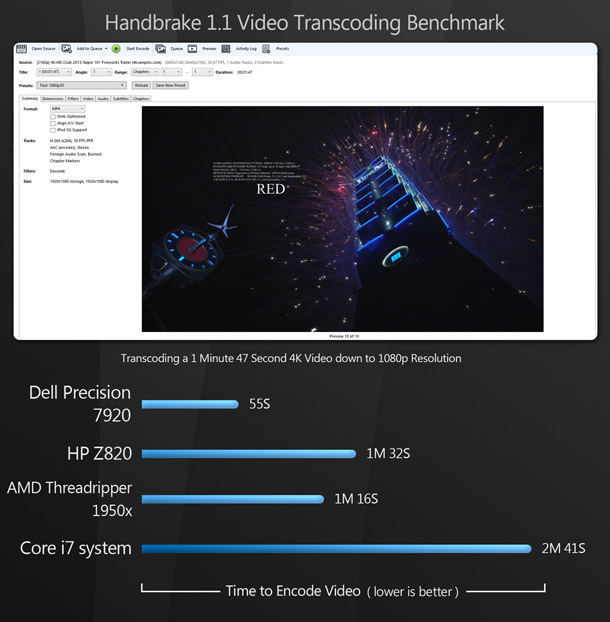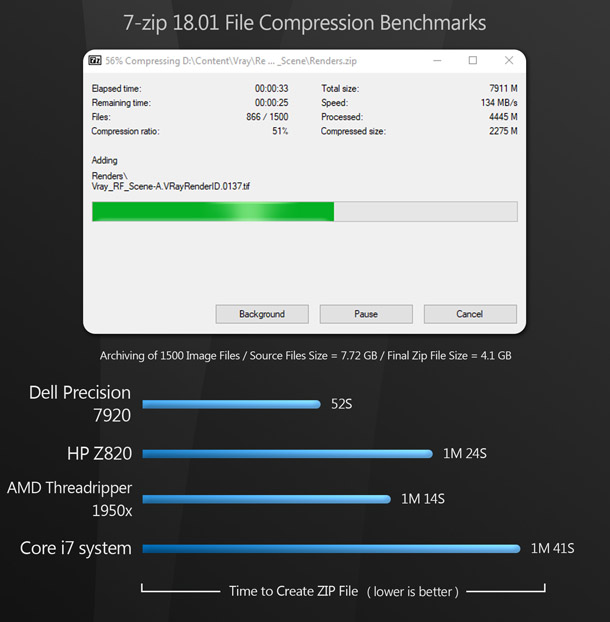Review: Dell Precision 7920 Tower workstation
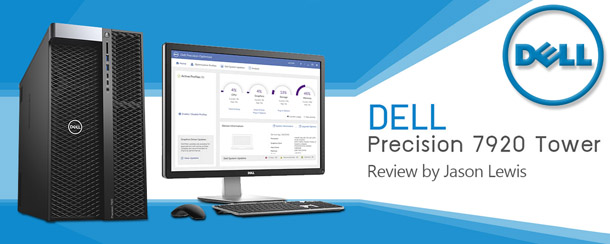
The price may put it beyond the reach of some users, but for demanding tasks like rendering or simulation, Dell’s top-of-the-range workstation is one of the most powerful DCC systems available, says Jason Lewis.
Welcome to our latest CG Channel hardware review. This time, we are looking at a high-end workstation from Dell, the Precision 7920 Tower. It’s part of Dell’s range of systems for businesses and professional users, and it is in this context that we will be looking at its performance for digital content creation.
The last Dell system I reviewed was a mid-range Precision T5600, back in 2012. It performed quite well, the only hindrance being the minimal 8GB of RAM, which hurt its performance in memory-intensive tasks.
Since then, a lot has changed. DDR4 memory is now standard, as opposed to the DDR3 used in 2012. CPU core counts have risen, as have CPU clock speeds, SSD drives are now mainstream, and GPU technology has improved significantly. This evolution in technology should result in some significant performance gains, but before we get into the benchmarks, let’s take a look at the current state of the PC market.
Market overview
Modern desktop PCs can be divided into four groups: consumer/entry-level, gaming PCs, workstations and servers. Consumer PCs are typically low-cost, low-performance systems using budget parts, and are geared towards non-demanding applications such as web browsing and word processing. In the last decade, notebooks and tablets have massively reduced the market share of consumer-level desktop PCs, their portability and relatively low cost appealing to people who do not require a performance-oriented system.
Gaming PCs are a significant step up in performance. CPU core count and speeds go up significantly, a dedicated GPU will almost always be present, and system assemblers add more memory and peripherals like SSD drives. Laptops are also making inroads into this market, but not at the same rate as consumer systems.
Next we have workstations, and it is in this category that our review system falls. Like gaming PCs, they are aimed at users with high performance needs, but are geared towards productivity software, or in our case, digital content creation (DCC) tools. Compared to gaming systems, workstations have more CPUs and higher CPU core counts, professional GPUs, even more RAM, and larger and faster internal storage solutions.
Lastly we have servers, which can also come in desktop as well as rackmount form. They are actually quite similar to workstations, just configured differently. Compared to DCC workstations, servers typically use CPUs with lower clock speeds but higher core counts; and have more RAM but have lower-performance GPUs and internal storage. Some specialist servers are more GPU-oriented, but these are not the norm.
A note on multi-core processing
Multi-core processors revolutionised desktop computing when they began to see mainstream adoption midway through last decade. Since then, counts have grown steadily, with high-end CPUs now topping out at 28 or 32 cores. While even consumer PCs benefit from more CPU cores, it is in workstations that the performance gains are most significant. DCC tools, particularly renderers, are some of the most multi-threaded applications in existence, meaning that they can allocate processing tasks to different CPU cores to run in parallel. The more cores you have, the more tasks that can run simultaneously.
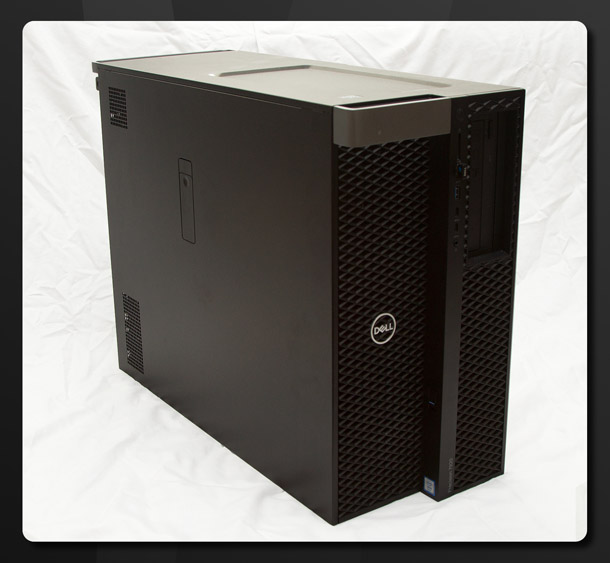
System specifications and price
Now let’s take a closer look at our actual test system, the Precision 7920 Tower. Along with HP, Dell is one of the leading suppliers of workstations to content creation studios worldwide, with firms like Lenovo and BOXX quite a bit further behind in terms of volume, along with Apple systems like the Mac Pro and iMac Pro.
The 7920 is Dell’s top-of-the-line desktop workstation and comes in a vast array of configurations. CPUs range from single six-core to dual 28-core processors, and memory from 8GB to 3TB (and yes, you read that correctly: you really can have Terabytes of RAM). Various professional Nvidia and AMD GPUs are available, in both single and dual-card configurations, and the 7920’s chassis can accept up to 10 internal hard drives. At the time of writing, the largest drive Dell offers is 4TB, but I’d expect this to rise in future.
Our test system falls neatly in the middle of this range, coming with dual 12-core Intel Xeon Gold 6136 CPUs, for a total of 24 physical CPU cores, or 48 CPU threads when Hyper-threading is enabled. Each runs at 3.0GHz, with a Turbo Boost speed of up to 3.7GHz for lightly threaded applications where not every CPU core is in use simultaneously. Memory is an impressive 192GB of 2,666MHz DDR4 ECC RAM, the GPU is a solid middle-tier Nvidia Quadro P4000, and for internal storage we have a single 512GB PCIe SSD boot drive and four 2TB 7,200 HDD data drives in a RAID 0+1 configuration. Bought commercially, it would set you back around $12,000.
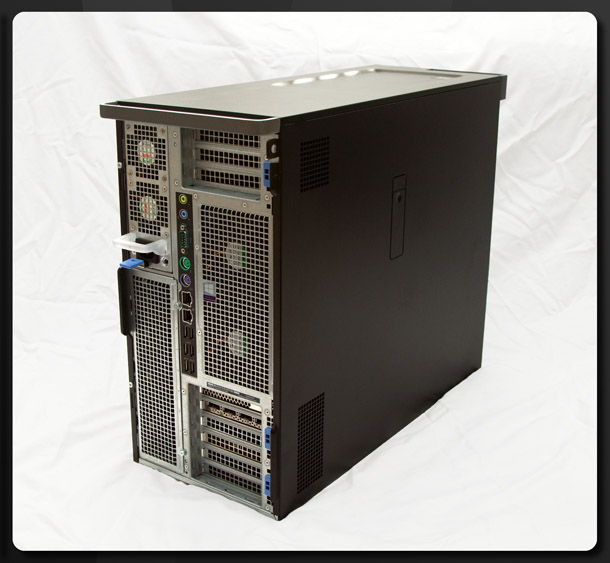
First impressions
Exterior design and connectivity
On the outside, the Precision 7920 Tower is everything you would expect a high-end workstation to be: large, understated, and black. The case design is a subtle evolution of the 2012 system, with the front almost entirely occupied by an intake grill to allow plenty of air to be brought in to cool the many high-performance parts. Two large carrying handles are integrated into the top of the case: a welcome addition, as the system is quite heavy and would otherwise be cumbersome to move around.
High-end systems typically have an array of external I/O ports, and the 7920 is no exception. On the front panel, there are two standard USB 3.0 ports and two mini USB 3.0 ports, all Type-C, along with an SD card slot and a headphone jack. On the back, there are six standard USB 3.0 ports, two Gigabit Ethernet ports, a PS/2 mouse and PS/2 keyboard port, a serial port, and audio/line-out and microphone/line-in jacks. For such an advanced system, I find the inclusion of legacy PS/2 and serial ports odd: for me, the space on the rear I/O panel would be better occupied by more USB 3.0 slots.
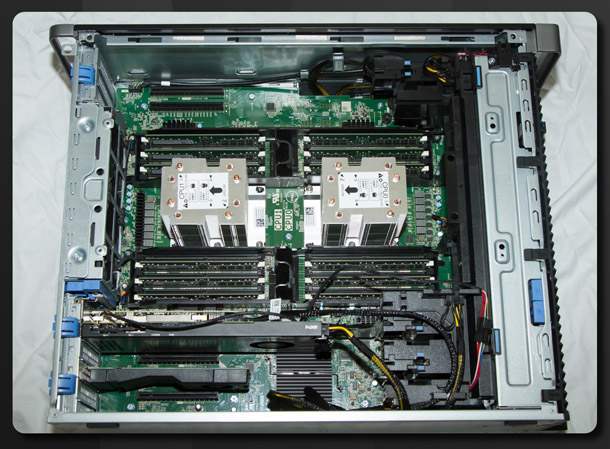
Interior design
While the outside of the 7920 looks pretty conventional, opening up the case reveals a more unusual layout, at least compared to systems I have reviewed in the past. The case initially looks quite shallow relative to its width, but closer examination reveals that it is divided into two chambers. The panel on the left side provides access to the main chamber, which holds the primary components: the motherboard, CPUs, RAM, and all the add-on cards such as GPUs, M.2 drives and I/O boards. The second chamber sits behind the first, and holds the internal storage drives and the power supply. My best guess for this design choice is a desire to keep the storage cooling separate from the system cooling, ensuring better data protection.
The CPUs sit in line with one another, with their cooling towers covered by a tunnel-shaped shroud with fans at the front and back. There is also a single fan that sits between the CPU cooling towers that sucks a large quantity of cool air in at the front, and expels hot air at the back. I have seen PC manufacturers rely on this kind of ‘wind tunnel’ design before, and while it offers adequate cooling performance, channeling large volumes of air through a small tunnel has its drawbacks – about which, more later.
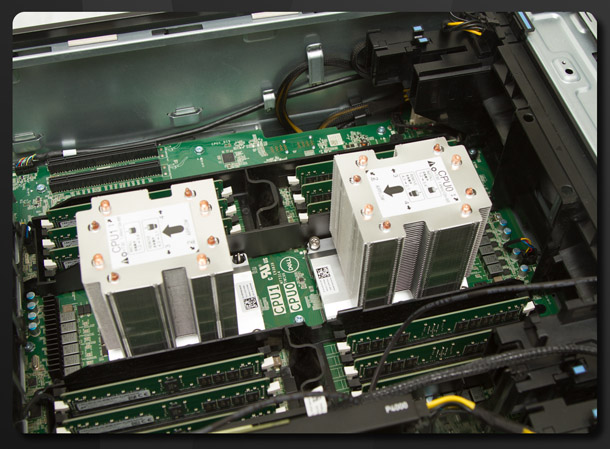
The motherboard layout is also a bit different to systems I have tested in the past. New high-end systems cram in a lot of components and expansion slots, and in the 7920, the board looks pretty cramped, with the CPU sockets close together and the 24 DIMM slots for RAM very close to the CPUs. The PCIe slots – there are six x16 slots and a single x8 slot – are divided into two groups, with five below the CPUs and two above.
Testing procedure
I compared the Dell Precision 7920 Tower to the last top-of-the-line workstation I reviewed: an HP Z280 with dual eight-core Intel Xeon 2687W CPUs, 32GB of DDR3 RAM, and a Quadro 5000 GPU – replaced in the current test build by a Nvidia GeForce GTX 1080. Internal storage originally consisted of a single 300GB 15,000 RPM SAS drive and a single 1TB 7,200 RPM SATA drive, which has also been upgraded to a pair of 256GB SSDs and several 2TB and 4TB 7,200 RPM SATA data drives. This was a very impressive system when we got it in 2012, and six years on, with its upgraded GPU and storage, is still a very strong performer.
To compare performance to more current systems, I borrowed a couple of additional test machines. The first has a 16-core AMD Ryzen Threadripper 1950X CPU, 64GB of 2,666MHz DDR4 RAM, and an Nvidia Titan V GPU. The other is a more mainstream desktop system sporting a quad-core Intel Core i7-6700 CPU, 64GB of 2,666Mhz DDR4 RAM, and an Nvidia GeForce GTX 1070 GPU.
The benchmarking procedure consisted of running a collection of digital assets similar to those you would find in a real production environment through typical tasks in the following software:
DCC packages
3ds Max 2018, Blender 2.79, LightWave 2018, Maya 2018, Modo 11
Games engines
Unity 2018.2.0b9, Unreal Engine 4.20.2
CPU-based renderers
Arnold 5.0, Blender 2.79 (using Cycles running on the CPU), Corona 1.6, KeyShot 7, Maxwell 4.2 (using CPU rendering), RenderMan for Maya 21.7, V-Ray 3.6 (using V-Ray Advanced)
GPU-based renders
OctaneRender 3.07, Redshift 2.6
Other tools
7-Zip 18.01, After Effects CC 2017, HandBrake 1.1, Marvelous Designer 7, Premiere Pro CC 2018, RealFlow 10, RealityCapture 1.0, World Machine 3022, xNormal 3.19
Internal benchmarks
Unity 2018.2.0b9 level build benchmark, Unreal Engine 4.20.2 level build and lightmap bake benchmarks
Synthetic benchmarks
Cinebench 15
Each test was performed 8-10 times, spread across 4-6 sessions, with the figure quoted being the mean of the highest and lowest values observed. All benchmarks were run at a resolution of 2,560 x 1,600px.
Benchmark results
3D performance
First, I tested the systems’ viewport performance, using a range of common DCC applications and game engines. In each of these benchmarks, higher figures represent better performance.
General viewport and in-editor performance is much more reliant on the systems’ GPUs rather than their CPUs, and as a result we see a pretty consistent pattern across these benchmarks. The Threadripper system always takes top spot due to its massively powerful Titan V GPU, with the Dell Precision 7920 Tower usually taking a close second place, the Core i7 system usually coming in third, and the Z820 in last place.
The poor performance of the Z820 is peculiar, given that in terms of raw compute, its Nvidia GeForce GTX 1080 should be the second most powerful GPU in this test. The most likely explanation is that it is bottlenecked by the older motherboard with Gen 3 PCIe and DDR3 memory, whereas all the rest of the systems are on the current Gen 4 PCIe and DDR4 RAM.
Rendering performance
Next, I tested rendering performance, using a range of CPU and GPU-based renderers. Rendering is one of the most processor-intensive tasks in DCC work, but also one of the most efficiently threaded, with performance scaling almost linearly with the number of CPU or GPU cores. Here, lower scores are better.
Here, the Dell Precision 7920 Tower with its 24 CPU cores takes top spot in all of the CPU rendering benchmarks, usually followed by the Threadripper system, the Z820, and – in a distant fourth place – the Core i7 system, clearly demonstrating that four newer CPU cores are no match for 16 older ones.
In the two GPU rendering benchmarks, OctaneRender and Redshift, the Titan V in the Threadripper system takes top spot, followed by the Z820 and its GeForce GTX 1080, the 7920 and its Quadro P4000, and the Core i7 system and its GeForce GTX 1070.
Additional benchmarks
Lastly, I ran a number of other tests that stress either the CPU or GPU. These included fluid and cloth simulations, video encoding, building game levels. Again, lower scores are better.
Most of these applications are multi-threaded, so in theory, performance should scale well with CPU cores. In practice, this holds true, although some applications scale to high core counts better than others.
All the simulation-based tests (RealFlow, Marvelous Designer and World Machine) scale well, as does xNormal texture baking, and Unreal Engine lightmap baking and level building.
Unity’s build tool should also be well-threaded, but here there is a smaller performance gap, so my hunch is that the test scene just isn’t complex enough to tax the build tool. With photogrammetry app RealityCapture we also see a small performance delta between the systems – again, probably due to the fact that our test only used 39 photos, whereas production-quality assets can be created from anywhere between 200 and 1,000 images. I imagine that if I added more photos, we would see a bigger gap between the systems.
All the video editing and encoding benchmarks also show multiple CPU core usage, but with nowhere near the same linearity as the rendering and simulation software. Again, this could be down to the fact that the benchmark scenes simply do not tax the systems enough.
However, despite the discrepancy in the efficiency of threading, the Dell Precision 7920 Tower always took first place, with the Threadripper system typically in second, the Z820 third, and the Core i7 system last.
Synthetic benchmarks
Synthetic benchmarks aren’t a great predictor of how a system will perform in procduction, but for ease of comparison with third-party reviews, I also ran Cinebench. Here, higher scores are better.
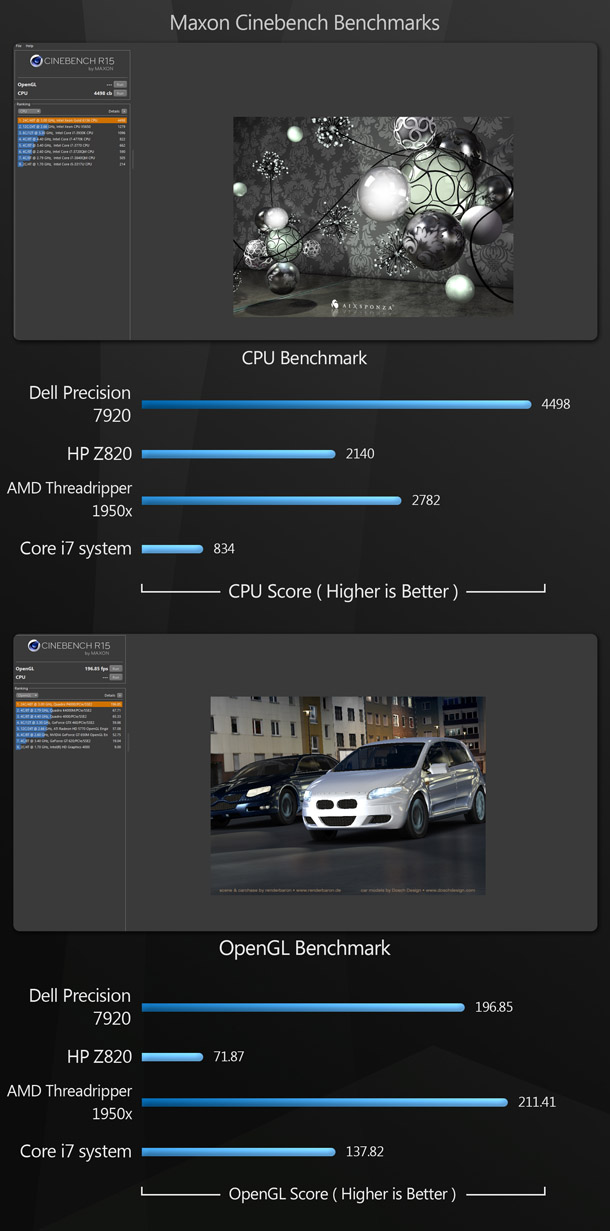
Results are broadly in line with the other benchmarks: in the CPU benchmark, the Dell Precision 7920 Tower comes out way ahead; in the GPU benchmark, the Threadripper system and its Titan V take a smaller lead.
Other characteristics
Cooling and acoustic performance
High-end workstations typically have non-standard cooling solutions, which – in my personal experience – don’t work that well compared to the setups found in gaming systems. As I mentioned earlier, workstation vendors tend to favor a ‘wind tunnel’ approach, which usually requires a larger number of smaller fans spinning at higher speeds to move enough air for adequate cooling. This often makes for a noisy system.
As configured, the Dell Precision 7920 Tower has nine internal 90mm fans. These are variable-speed units that are supposed to spin up or down depending on the thermal load of the CPUs, and at default speeds, the system is whisper-quiet. However, at these speeds, the CPUs can get very hot, especially the second CPU, which sits directly in line with the first. In my opinion, this is a poor layout, as the single fan that sits between them pulls air over the first CPU before blowing the resulting heated air over the second. When the CPUs were under 100% load, CPU 1 sat at 75-78°C and CPU 2 at 96-99°C: an average difference of around 20°C.
Using the manual fan controller in HWiNFO, I could turn the fan speeds up to maximum, which brought the CPU temperatures down to a safer range (53-57°C for CPU 1, and 67-70°C for CPU 2), but at the cost of making the system very noisy.
The older Z820 had the same problem with its default cooling – a similar set-up to the Dell system, using 90mm fans, but with smaller heat-pipe towers – so I removed them and replaced them with a pair of 120mm Noctua coolers (similar to these ones). They make barely any noise, and keep the CPUs 15-20°C cooler under full load than the default coolers. The Threadripper system in our test used water cooling, which offered excellent performance and nearly silent operation, even when the CPU was running at full load.
I do find it odd that the 7920 doesn’t use more efficient 120mm or 140mm tower coolers with dedicated fans for each CPU, even if that would mean making the case a little wider – and even more odd that in such a high-end system, there isn’t even an option for liquid cooling.
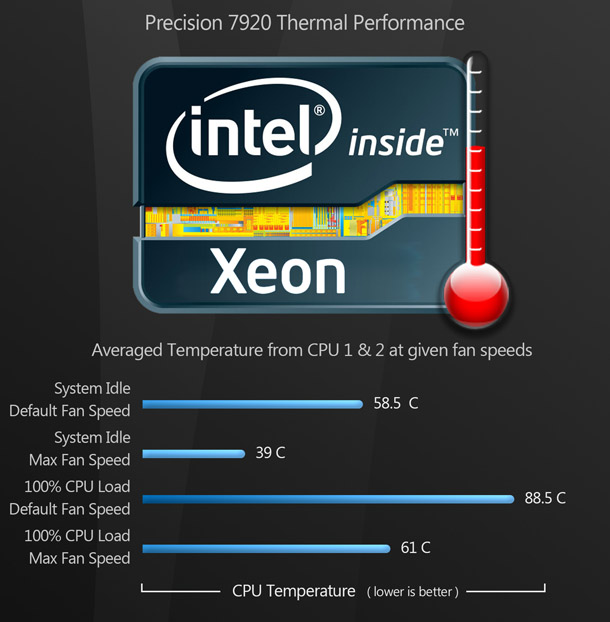
Power consumption
With the ever-increasing cost of electricity, power usage has become a very real concern when choosing a new workstation. While throwing more and faster hardware at a system will increase its performance, it also increases its power usage, and when you have an animation studio filled with hundreds of workstations, the difference between systems that draw 100-200W of electricity and those that draw 500W can be thousands of dollars a year. Even for individuals, it can make a noticeable difference if you use the system frequently, especially if you are constantly doing computationally intensive tasks.
I tested power usage with a Kill A Watt P3 P4400 meter, and while not as advanced as some of the more expensive meters out there, it gives a pretty good estimate of the system’s average power draw in various usage scenarios. Let’s take a look at how our test systems stack up.
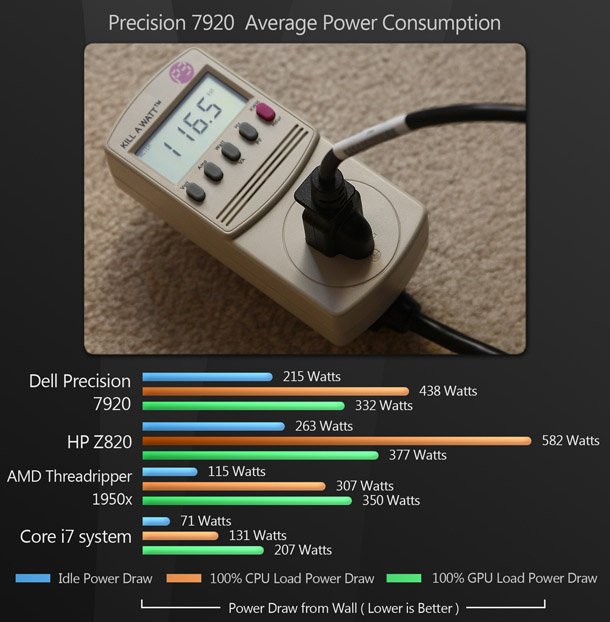
When comparing the Dell Precision 7920 Tower to the older Z820, it is apparent that the past six years have yielded some significant improvements in power consumption: the 7920 adds eight CPU cores and more than 100GB of RAM, yet consumes significantly less electricity in all power states.
The interesting results come from the Threadripper system, as it consumes significantly less power than the 7920 at idle and under CPU load. It does have eight fewer CPU cores than the 7920, but with a difference of over 130W under full CPU load, the most likely explanation is that two physical processors will almost always consume more power than one, since the integrated memory controller accounts for a significant part of the power consumption. Under GPU load, the Threadripper system’s power consumption is a bit higher, but this is to be expected, as its Titan V is a 150W card, compared to the 7920’s 105W Quadro P4000.
As expected, the Core i7 system, which has the least performance-oriented hardware, comes way below the other systems in power consumption.
Pricing
Workstations typically use premium components, and with premium components comes a premium price. While the Dell Precision 7920 Tower starts at $2,269, with upgrades, it can easily hit five figures: our test system comes in at roughly $12,000.
While typical PC enthusiasts may cringe at that figure, you need to look at who the 7920 is intended for. Modern films and games have budgets that range from millions to hundreds of millions of dollars. Purchasing a handful of workstations in the $8-12,000 range represents only a fraction of that budget, particularly when you consider that the licensing costs for high-end DCC software can be higher than the hardware on which it is run. With development and shooting schedules becoming shorter every year, the phrase ‘time is money’ can be interpreted quite literally in the DCC market. In many cases, if a visual effects studio runs over deadline, it has to fund the remaining work itself. The Dell Precision 7920 certainly carries a professional price tag – but is it worth that cost? Many professionals, myself included, would say yes.
Overall verdict
I have spent several months with the Dell Precision 7920 Tower system reviewed here, integrating it into my regular work pipeline and overall, have found it to be the fastest workstation I have ever used. It packs some of the highest-performance components available today into a high-quality, efficient, and – the cooling solution aside – well-thought-out package. The only area where it seemed underpowered was its mid-range Quadro P4000 GPU. In reality, a system like this should be equipped with a high-end GPU, such as an Nvidia Quadro P5000 or P6000, or an AMD Radeon Pro Duo or Radeon Pro SSG.
The real question is: do you need a workstation with 192GB of RAM and 24 CPU cores? That depends on what kind of tasks you are going to throw at it. For pure asset creation, animation, compositing or colour correction, it’s probably overkill. The real benefit of the extra horsepower comes with CPU-intensive tasks like rendering, simulation or building real-time projects. Shader artists, lighting TDs, and anyone doing scene layout will find the low iteration times invaluable.
Artists rendering at very high resolutions, as in architectural or product visualisation, will also benefit, as will anyone whose workflow involves a lot of multi-tasking. For example, if you’re a 3D generalist, you could be rendering or encoding video streams in the background with low-priority threads, while working on assets or compositions in another application. The 7920 could also fit well in a render farm: with 24 CPU cores in one machine, it occupies much less space and uses much less power than multiple four or six-core systems.
If you’re looking for a workstation that can handle some of the most extreme computing tasks in DCC work, look no further than the Dell Precision 7920 Tower.
Jason Lewis is Senior Environment Artist at Obsidian Entertainment and CG Channel’s regular reviewer. In his spare time, he produces amazing Star Wars fan projects. Contact him at jason [at] cgchannel [dot] com
Acknowledgements
I would like to give special thanks to several individuals for their help with this article:
Brett Jacobs of Dell
Stephen Schmitt of World Machine
Bruno Oliveira on Blend Swap
Reynante Martinez
Stephen G Wells
Adam Hernandez
Find out more about Dell’s Precision workstations on its website

